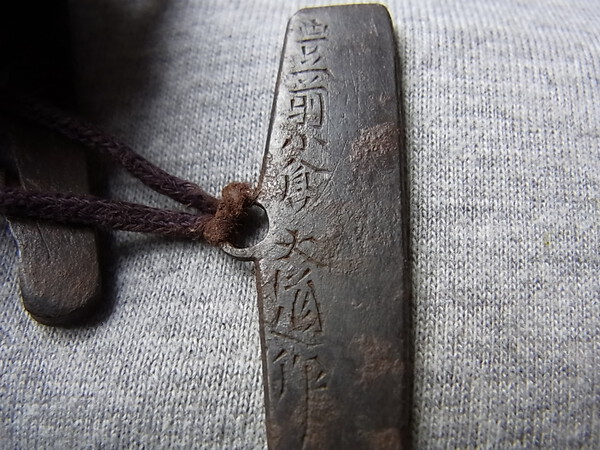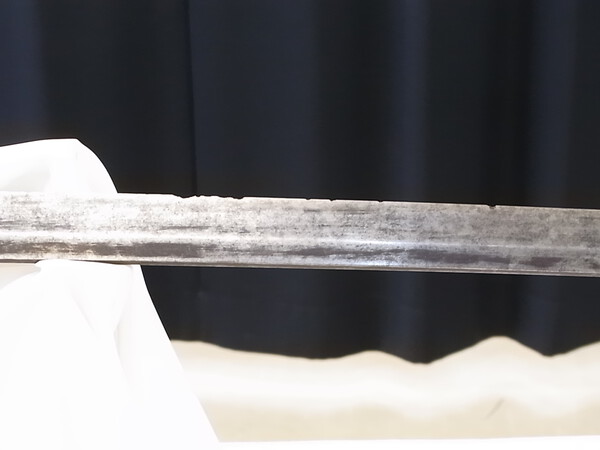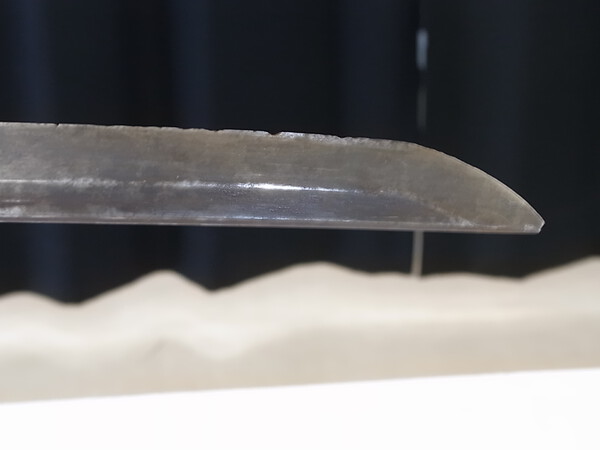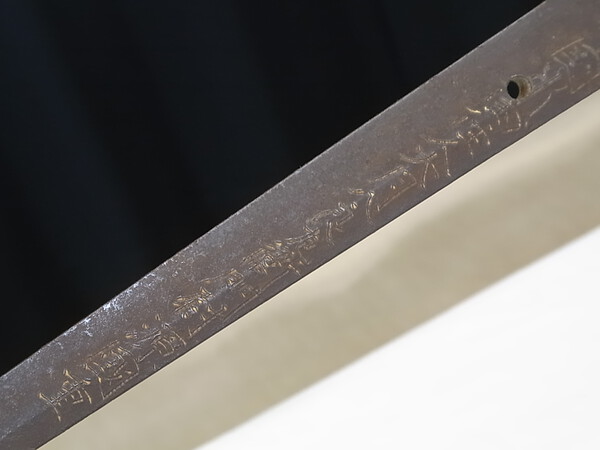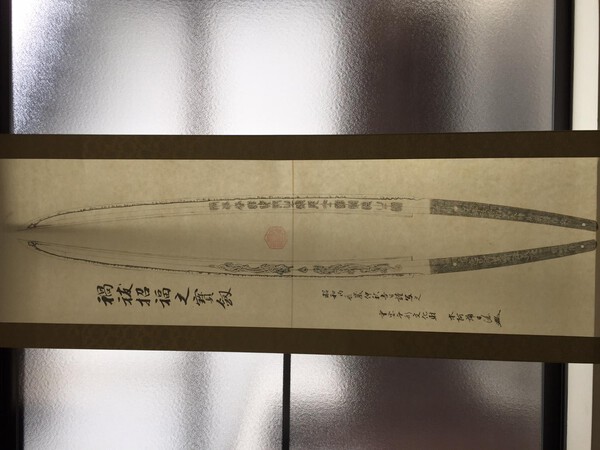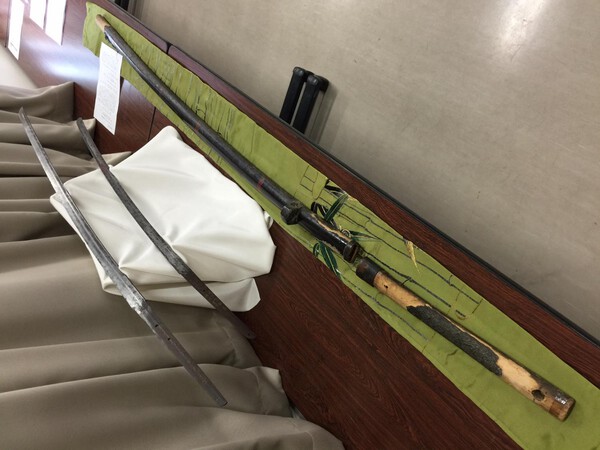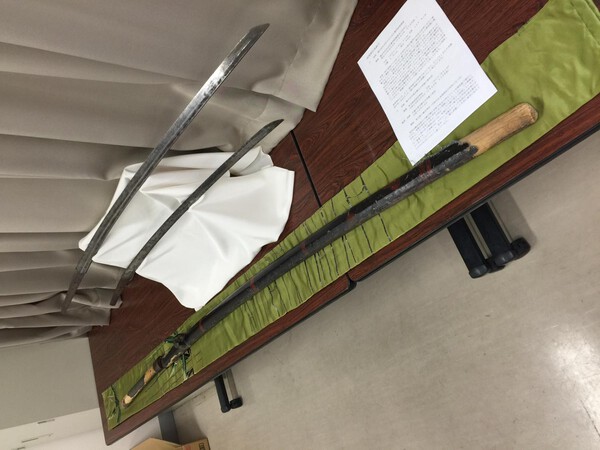-
Posts
14,270 -
Joined
-
Last visited
-
Days Won
274
Content Type
Profiles
Forums
Events
Store
Downloads
Gallery
Everything posted by Bugyotsuji
-

New Member Introductions
Bugyotsuji replied to Dusty62's topic in General Nihonto Related Discussion
Hi Rob, have you read Knutsen's book on J pole arms? http://www.goodreads.com/book/show/1018392.Japanese_Spears -

Edo Period Corner Part II
Bugyotsuji replied to estcrh's topic in General Nihonto Related Discussion
Over the years I have noticed my collection of Japanese Hi-uchi-gane flint steels growing little by little. This Tuesday at an antiques fair I found four on the same day! Cleaning the rust off them is a delicate task, but today I was rewarded with a legible Mei on one. (Usually such marks are hit fairly randomly, and no-one to my knowledge is able to read them). 豊前小倉大道作 it says. Buzen Kokura O-michi (Daido) Saku. Well, there was a Buzen Kokura Han during the Edo Period. Kokura Castle, residence of the Hosokawa and then Ogasawara families, proclaims it. There was also a line of O-michi swordsmiths forging there in early Edo at least... -

Nihonto Collections In The Uk
Bugyotsuji replied to Robunder's topic in General Nihonto Related Discussion
Get to a Token meeting if you can. There are a couple of Nihonto displayed in the Tower of London, and a good Japanese section up north in the Leeds Royal Armouries, both places well worth a day trip. -

Nihonto Collections In The Uk
Bugyotsuji replied to Robunder's topic in General Nihonto Related Discussion
The Japan Rooms also had a Yosozaemon no Jo Sukesada katana on display when I went last went. Minimalistic perhaps describes their exhibition. A little bit of everything. -
Well, I guess I am Mr Popular now. Not. Yesterday I went round (40 mins drive from here) to the exhibition to follow up on a promise to edit their English exhibit cards. After an hour or two I handed over five pages of hand-written notes. One classic comment was about a lovely Chogi blade, "It is worth nothing..." (instead of noting). The young lady in the office who had been elected to type out the original captions stepped forward, extremely embarrassed, explaining that she had always been bad at English. "No-one who is bad at English could have typed all that", I said. "A misprint or two is completely natural. Blame Bill Gates for the predictive texting!"
-

"ho-No-To Kenma Project"
Bugyotsuji replied to Bugyotsuji's topic in General Nihonto Related Discussion
The chairman of the local NBTHK said he is hoping that all this publicity will reach out-of-the-way shrines and lead to further discoveries and restorations. Apparently he took some heavy criticism for this adoption of 'western' crowd funding, but it looks as though he has been vindicated by the strong results so far. -
Can't figure out the second character. Sanzui hen, tori? 西X氏 ending with the honorific, suggests that this may be the owner's name. (?) Personally I feel ambiguous about many of these guns, perhaps because I am a romantic, they being a sign of the turbulence of the ending of a Golden Age. Many have a mixture of Victorian and Meiji Tenno feel to them. This one does have a good solid balance to it, though.
-

"ho-No-To Kenma Project"
Bugyotsuji replied to Bugyotsuji's topic in General Nihonto Related Discussion
This Kunishige smith was one of about 40, it is thought, not all of whom are recorded. I guess that includes the female smith, Onna Kunishige, mentioned on another thread here. I have a Long-hafted (12 feet), short-tipped (7 cm), Sei-sankanku (equilateral triangular cross-section) spear, nakago signed "Yamashiro no Kami Kunishige" which some time ago I tried to research but "not Mizuta, probably Musashi" is as far as I got. -

"ho-No-To Kenma Project"
Bugyotsuji replied to Bugyotsuji's topic in General Nihonto Related Discussion
Sadly the Jinja has no permanent on-site resident any more, and several things have been stolen. There is a lady at another shrine who is now now responsible for both, but the responsibility is too much for one person. -

"ho-No-To Kenma Project"
Bugyotsuji replied to Bugyotsuji's topic in General Nihonto Related Discussion
Taken with the regular camera before the opening speech. (30 years ago there were no chips in the blade, apparently...) -

"ho-No-To Kenma Project"
Bugyotsuji replied to Bugyotsuji's topic in General Nihonto Related Discussion
Apologies, the iPhone photos think they know better... Heel! Heel! Grrr.... Hardly worth it now if the pc is going to mess around, but here is an oshigata of a previous project some years ago of a beautiful Henmi Toyo HonoTo, just before he switched professions. -

"ho-No-To Kenma Project"
Bugyotsuji replied to Bugyotsuji's topic in General Nihonto Related Discussion
There are actually two more swords at the Jinja, Daisho by Sukekuni. (The katana was displayed beneath the Kunishige yesterday.) -

"ho-No-To Kenma Project"
Bugyotsuji replied to Bugyotsuji's topic in General Nihonto Related Discussion
Went to the kick-off of this project today. Quite a bit of interest from the general public, and the money they were hoping for has already been pledged. Got some before shots of the Hono To, plus another brother (shorter) blade which is also wagging its tail. Will post shortly. -
Went back for another look today as they are changing the swords this very evening for the start of the second half. Very few people there so I was able to concentrate a little more this time. The spelling boo boos are not a problem if you are not a grammar Nazi and you have a forgiving heart. They result from various causes, including probably predictive texting, and an ability to slip through spell checkers. Off the top of my head, one panel said that Togo Heihachiro's Yasufusa steel is blight. One of the Nagamitsu blades had a flamboyant human. 宗吉 in English was Munetoshi in the first line of para 2, and Munyoshi in the 5th line. One suriage tachi mei was folded around and described as having been placed in a special flame.
-
PS The shop at Osafune Sword Museum ordered 50 copies of the illustrated catalog, which have now nearly sold out, so they have ordered in another 60, according to word on the ground. PPS Re-reading the English captions at the exhibition I found several examples of odd English. How did those creep in, I wondered?
-
Went to see this yesterday for the first time. "Upstairs you should start at the right and move round", they told me. "In historical order." Everyone upstairs was intuitively flowing the other way round, breaking my concentration. Stuff this, I thought. Is it just me or do others feel more regarding a sword that is known to have taken part in some famous event in history? Perhaps it is my lack of serious study that goes for the easy cop-out? For example, there was the actual Yoshifusa that Admiral Togo Heihachiro wore on the top deck of the Mikasa during his epic battle against the Russian fleet in the Tsushima Strait in 1905. And here was an Ichimonji, given by Oda Nobunaga to Okudaira Nobumasa in thanks for defending Nagashino Castle against the hugely superior forces of Takeda Katsuyori in 1575. How about this Naritaka Tachi bestowed with gratitude by Minamoto no Yoritomo upon Sawara Yoshitsura for leading his supporting cavalry charge down the 'impossible' cliffs at Ichi-no-Tani in 1184? Since the second part of the exhibition will be introduced next Friday I am planning to go again on a regular weekday before that, and look more deeply into those blades. Yesterday (Saturday) there were just too many people, headed the 'wrong' way round, although they said it had been quiet in the morning.
-

"ho-No-To Kenma Project"
Bugyotsuji replied to Bugyotsuji's topic in General Nihonto Related Discussion
In the West. Collections are left to museums in people's wills and lie untouched because there may be no person qualified to decide what to do with them. Years and years of records pile up, higgledy piggledy, and new staff move in and out, and it's no wonder that there is no-one all-round enough with the power or the will to sort it all out. There are drawers of tsuba at the Fitzwilliam Museum in Cambridge that no-one has sorted, and at the Ashmolean in Oxford there is the amazing Church collection of Ojime that a friend and I looked at last year for the first time in anyone's living memory. -

"ho-No-To Kenma Project"
Bugyotsuji replied to Bugyotsuji's topic in General Nihonto Related Discussion
Rick, it will go to the Bizen Osafune Sword Museum, or possibly to the Prefectural Museum in Okayama City. (I know that the Osafune storeroom is required to be kept at a constant temperature and humidity. Swords that they bring out for lectures, conferences etc., appear to be in pristine condition.) Whether the 1,000,000 JPY is solely for the polishing or goes partly to the shrine as compensation, I do not know, but for the sake of future generations the shrine in such a deal agrees to let the sword be preserved and maintained elsewhere. -

"ho-No-To Kenma Project"
Bugyotsuji replied to Bugyotsuji's topic in General Nihonto Related Discussion
Ken, many thanks. They were explicit that they cannot take donations from abroad. (Perhaps it is related to why PayPal in Japan for example cannot accept foreign currency payments?) The basic level of support was 3,000 JPY for your name in the book. For a 5,000+ JPY donation people will at some point get the oshigata, apparently. -

"ho-No-To Kenma Project"
Bugyotsuji replied to Bugyotsuji's topic in General Nihonto Related Discussion
Ah, yes, but how do you get those long 'o's?


